Or,
Becoming ‘Book Guardians’ of the Past,
for those of the Future
 (Oliver and Boyd’s Object Lesson Cards ca. 1880s)
(Oliver and Boyd’s Object Lesson Cards ca. 1880s)
A couple of years ago, I was invited to give a presentation to the Cambridge Bibliophile Society. Like any good modern researcher, as I sat down to prepare my talk, my first recourse was to google the Cambridge Bibliophiles. I was drawn to their twitter feed introduction: ‘Between the pages and dusty shelves you’ll find us: the book-lovers, book-collectors, book-guardians, book-users and bibliophiles of the University of Cambridge’. Book guardians – what a wonderfully evocative phrase, and one which certainly resonated with me personally. From the small child saving their pocket-money to collect a weekly annual, through the student buying second-hand novels, the librarian or curator finding a unique item which will enhance an existing collection, or perhaps the successful and more affluent collector bidding on the long sought-after treasure – I think we all share this feeling that by filling our personal shelves with our favourite things, that we become their custodians for their time spent with us, to be treasured, protected, and loved.
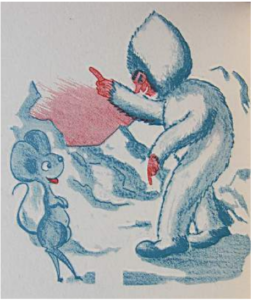 (Oliver Seligman, Hoppy in Quest of Fortune, 1974)
(Oliver Seligman, Hoppy in Quest of Fortune, 1974)
The drive to collect is as old as time, and this is no less true for those of us compelled to seek out rare books, manuscripts, and ephemera – which in my case happens to be focused upon the history of science and medicine. It is frequently a ‘bug’ caught young, often (though by no means exclusively) developed during academic study, and then fuelled and funded by an often-associated career. Many are driven and share the growing thrill of the hunt to find better and more elusive tomes. It can become competitive; collections can become status symbols; many go on to have cultural and historical significance and resonance. A common link, however, amongst the best collections, is that they are usually amassed by those who buy books that they love, in the best condition that they can afford, and which reflect their personalities and interests.
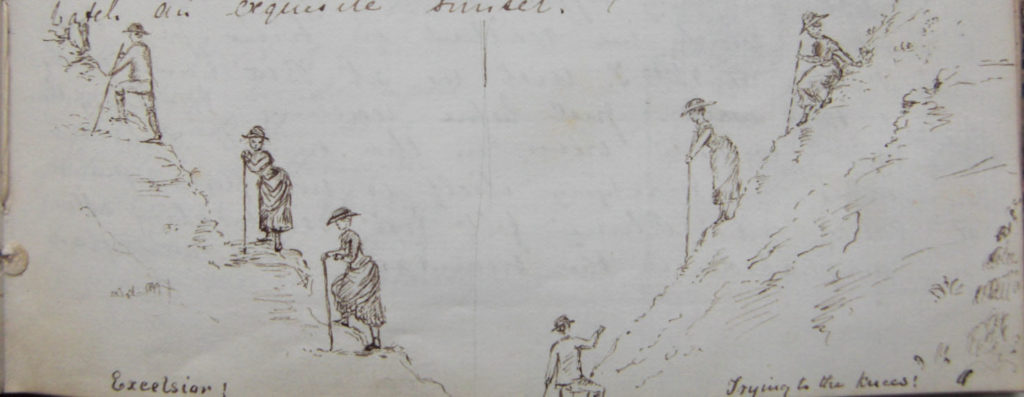 (Alpine Travel by an Unknown Female Adventurer)
(Alpine Travel by an Unknown Female Adventurer)
A printed book, a manuscript cookery book, a traveller’s diary, a framed map, or a small trade card perhaps – all deserve to be collected for they delight the mind and senses, and can transport us to other worlds. Ownership inscriptions tell of far-off places, of friendships and enmities, of lost loves. Many have travelled far and wide from their original place of origin, and have a tale to tale or secret to reveal. To quote my colleague, and one of the founders of the York Antiquarian Book Seminar, Jonathan Kearns, they are ‘time capsules waiting to be unearthed’, and can celebrate both the ordinary and extraordinary. What is so fabulous, however, it that they are a uniquely personal selection, which reveal much about ourselves. As dealers, we are here to try and help you on your collecting journey. We can advise, and point things your way, but the choice is yours, until that time when you decide to hand over the baton of custodianship to a new guardian.
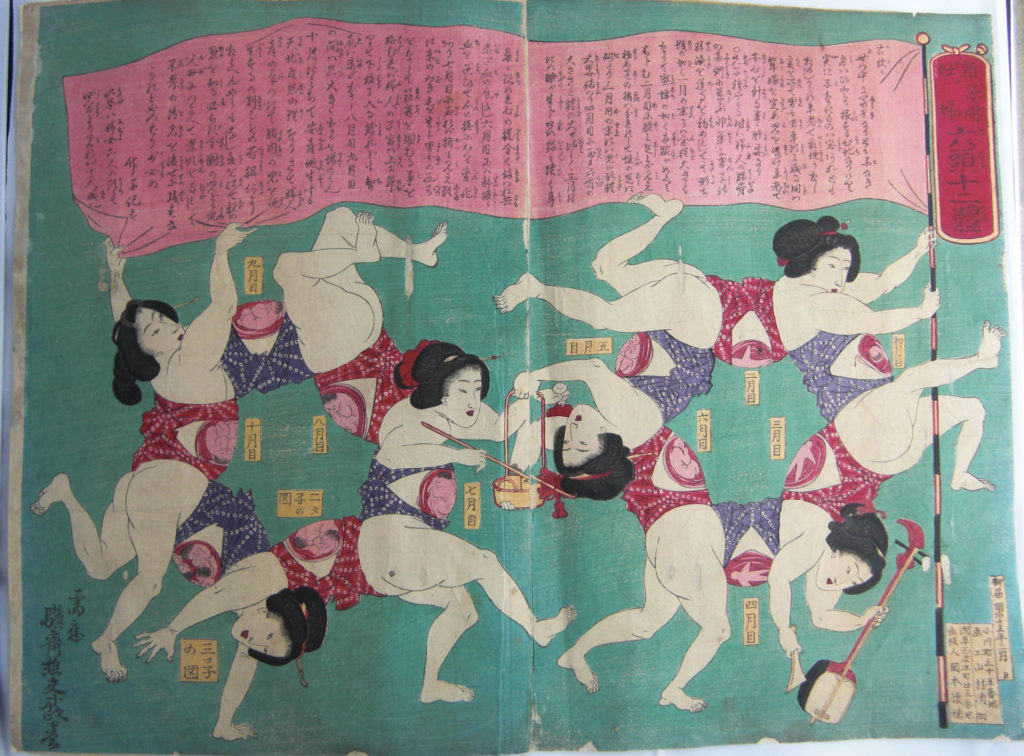 (Kiyosuke Yamamura, A New Invention, Pregnant women with Six Heads and Twelve Bodies, Tokyo, 1882)
(Kiyosuke Yamamura, A New Invention, Pregnant women with Six Heads and Twelve Bodies, Tokyo, 1882)
As part of one of the ABA-IES Book Collecting Seminars, on the topic of Collecting Science Books: The ‘How’s’, the ‘whys’ and the ‘wherefores’ , together with a young science collector, and a lead curator at the Wellcome Library, we each offered up our own perspectives as dealer, private and institutional buyer and collector. What became apparent, was that there is much more that united us than divided us – with the one obvious difference being that dealers are driven by financial necessity to part with their purchases rather than curate them! Nevertheless, the collecting bug – the thrill of the chase for that elusive treasure which delights and captivates both private and Institutional customers alike – is a thrill shared by dealers as well.
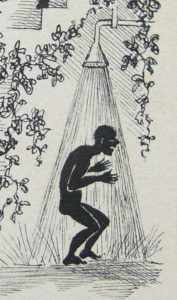 (Hydrotheraphy, Engraved Broadside from Schoenbrunn, ca. 1880)
(Hydrotheraphy, Engraved Broadside from Schoenbrunn, ca. 1880)
Leona Rostenberg and Madeleine Stein – two of the most influential women booksellers of the 20th century – had a wonderful term to describe the thrill of finding a book, and which they described in their memoir Old Books, Rare Friends that of ‘finger-spitzengefuhl’: “A tingling of the fingertips becomes an electrical current of suspense, excitement, recognition. In an artificially controlled voice, one of us calls to the other, ‘Look! This may be something.’ And two heads look down upon the title page of a discovery. Sometimes the finger-spitzengefuhl occurs on the spot as we scan the shelves of a foreign dealer. Sometimes it takes place only after the purchase has been made and we study our finds. Whenever or wherever it occurs, it is an experience that makes the rare book business a hymn to joy.”
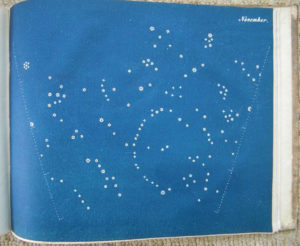 (Josephine Edle von Ranlom, Aufblick zu den Sternen-Welten, Wien, 1846).
(Josephine Edle von Ranlom, Aufblick zu den Sternen-Welten, Wien, 1846).
This joy unites ALL collectors! When I joined Pickering and Chatto in 1994, the collecting of science books, and indeed book collecting in general, was very much the preserve of gentlemen of a certain vintage – although there were some notable exceptions, perhaps most famously Mary Hyde, Viscountess Eccles, with her collection of Dr Johnson and Early Modern Books. Many of the major science collectors, however, went on to either sell or donate their collections to leading academic Institutions, and which now form the nucleus of some world-leading research centres, for example Roy Neville’s Chemical Collection which now resides at the Chemical Heritage Foundation in Philadelphia.
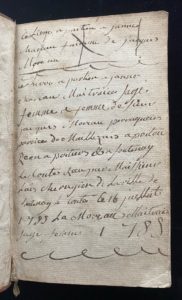 (Jean Le Bas, Précis de doctrine sur l’art d’accoucher, Paris, 1780)
(Jean Le Bas, Précis de doctrine sur l’art d’accoucher, Paris, 1780)
Much has changed in the intervening period, however, and I am happy to report that much work is being done by both academics, librarians, collectors, and dealers, to correct both the imbalance of gender and diversity. There are many such examples, but the work and collection of Lisa Unger Baskin has been particularly instrumental in highlighting historically underrepresented voices. Her extraordinary collection is a transformative body of material documenting women at work, including significant documents relating to suffrage and anti-slavery, now located at Duke University, and will be an invaluable resource to scholars in numerous fields for many years to come. Florence Fearrington, another of the preeminent female rare book collectors of the day, has recently donated nearly 4,000 books and objects relating to natural history, malacology, and Wunderkammers, to the University of North Carolina at Chapel Hill.
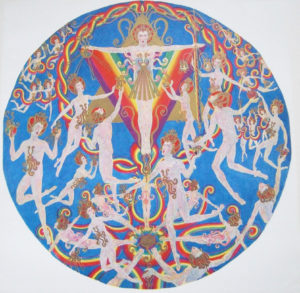 (Ethel Le Rossignol, A Goodly Company, 1933)
(Ethel Le Rossignol, A Goodly Company, 1933)
There is still room for much more improvement – but collecting really is for everyone, and dealers across the globe are working hard to break down traditional barriers, and to try and make the rare book world less intimidating, less discriminating, and instead more welcoming, inclusive and all-embracing. In addition to such initiatives as the Honey & Wax Book Collecting Prize, a number of leading Book Seminars now offer scholarships in the interests of promoting diversity all across all fields, and to help those from historically underrepresented communities (see Further Studies). Rebecca Romney and Brian Cassidy, of Type Punch Matrix are leading the way in terms of making public their commitment to social justice accountability, and in so doing are helping to start much needed conversations amongst the wider rare book community. The ABAA indeed, have recently established a Diversity initiative, to explore issues of diversity, equity, and inclusion facing the organisation, and no doubt other National Associations will follow suit. The days of the rare book world being an exclusive club are on the wane.
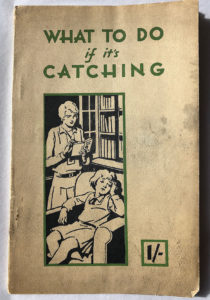 (Public Health: What to do if its Catching, Sheffield, n.d. but ca. 1930s)
(Public Health: What to do if its Catching, Sheffield, n.d. but ca. 1930s)
Through my involvement with the ABA National Book Collecting Prize, I am happy to confirm that there is a thriving community of new collectors in all fields. Several UK Universities run individual book-collecting prizes, and book collecting is very much alive and well. There are many inspiring and active young collectors, and a number of new thriving bibliophile groups and societies emerging. The range of collecting interests never ceases to amaze and inspire us, with the three past winners focusing upon Children’s Literature 1880-1945; Monolingual Latin books, Cold War era propaganda books, and early Egyptologists respectively. Other topics included books on fashion; Victorian Natural History books; Book-trade Salesman’s samplers or ‘canvassing’ books. In the words of Honey & Wax Proprietor Heather O’ Donnell, aspiring collectors should ‘pay attention to the books that fascinate them, even if they’re not yet sure why. What do you see that others don’t? If you have a theory about the stories your collection might tell, and the curiosity to find out if you’re right, you’re a real collector in the making’.
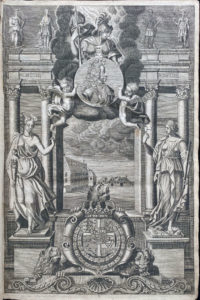 (Oliger Jacobaeus, Museum Regium, Copenhagen, 1699)
(Oliger Jacobaeus, Museum Regium, Copenhagen, 1699)
So, a few top tips!
- Choose a topic or theme that really excites you. It could be related to your field of study. It could be place specific. Perhaps a significant historical event or up-coming anniversary may ignite your collecting interest. It can take time to figure out exactly what you want to collect, but in time your collection with develop a focus.
Some strong areas of interest at the moment are Women in Stem; Manuscript and archival material – items which are by their very nature unique and copy specific, and which can tell much about previous ownership and readership; counter-culture; the graphic arts; printing history and history of the book; pulp fiction. Be mindful that this may inevitable lead to competitive prices.
- Condition matters. Try and buy the best copy that you can afford at the time – you can always ‘upgrade’ when funds allow. This is especially true for Modern First books, but for older material, condition can sometimes be less of an issue. Increasing interest in the history of the book, and printing history means that condition can reveal much about the books production and readership etc. Original and unrestored condition can be seen as a positive – all part of the ‘archaeology’ of the book (to adapt a phrase used by Roger Gaskell). The condition of the book helps to tell its story – how it was handled and read, how it was put together etc. Signs of use, and copy specific factors, all help to add to our understanding of the text – and help to tell the story, and link us to the lives of previous owners. If aesthetics is your thing, however, then the ‘dog-eared look’ may not be for you – and of course may make it harder to pass on in the future.
- Scarcity will be a factor – although not always one that necessarily makes a price prohibitive. There may be a reason why there is only one copy of a book – it really wasn’t very good! Don’t let this put you off, however, collecting what you are truly passionate about.
- ‘Heart over Head’ or the ‘Oh – I’ve not seen that before’. There will be times when you simply just fall in love with something. Over time, gut instinct that something is fun or interesting, often (though not always) proves right! As a dealer, I know that if I have fallen in love with something, then 8/10 times someone else will. Collect the books you love – it works for both dealers and collectors.
- A selection of a few good reference books will be of help. Even with the wealth of online resources now at our fingertips, a selection of printed sources will give you a solid foundation for understanding what is out there to collect. For some suggestions relating to the fields of science, medicine, printing history, and women in science, see here.
- When circumstances allow, there is no substitute for viewing and handling material, so visit shops, and fairs, and talk to dealers. We are here to help! Don’t be afraid to ask questions. Details of local book fairs (virtual and in due course, all being well, physical) can be found at the PBFA; ILAB, and the ABA. Members of all Associations abide by strict codes of practice and ethics, and so you can buy with confidence.
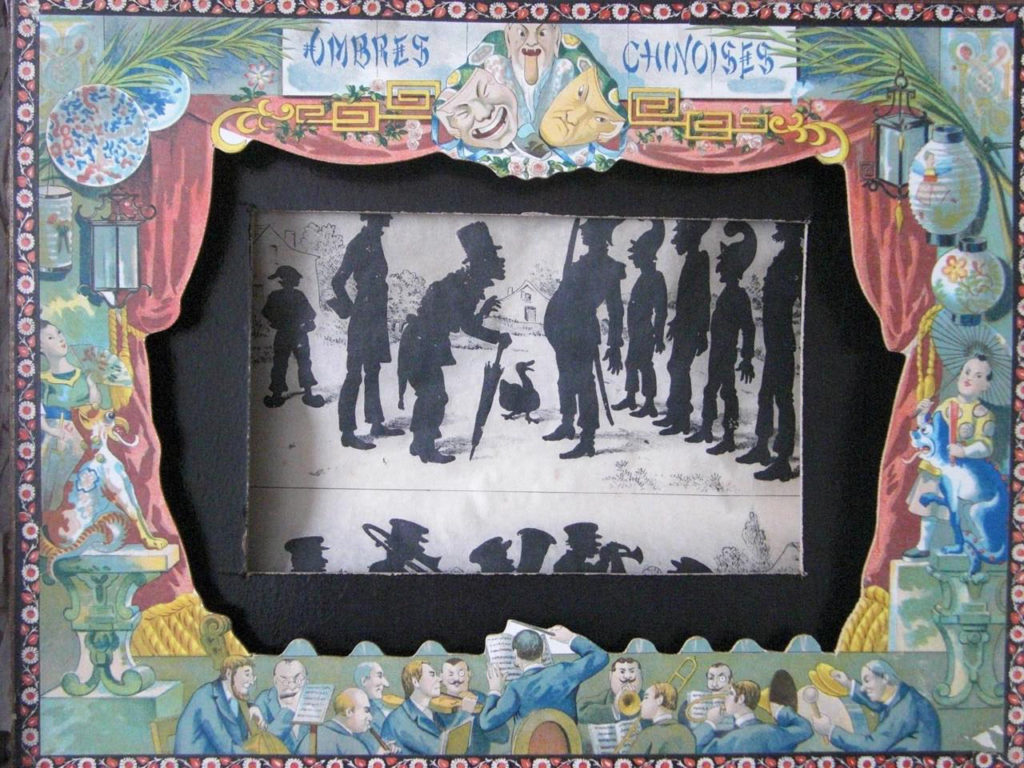 (Games and Amusements – Shadow Theatre, Ombres Chinoises, Mauclair-Dacier, Paris, ca. 1900)
(Games and Amusements – Shadow Theatre, Ombres Chinoises, Mauclair-Dacier, Paris, ca. 1900)
It was always drummed into me early on, never to promote book collecting as an investment, and I still feel that this remains true to this day. Most start from very humble beginnings with no hope of monetary gain – but as auction sales over the years have proven, book collecting can at times be financially rewarding, with some thoughtful curation. Historically, rare books tend to hold their value, though some subjects to do go out of fashion, and like any investment there is an element of risk involved. Ultimately, however, the aim is that your collection should thrill and delight you, and bring comfort and joy – never more important than during our current times.
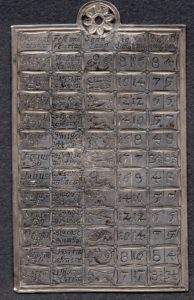 (Unique Engraved Silver Perpetual Calendar Plaque, n.p. bu German, n.d. but ca. 1750s)
(Unique Engraved Silver Perpetual Calendar Plaque, n.p. bu German, n.d. but ca. 1750s)
*Images just a few of my own favourite things sold over the past five years)
